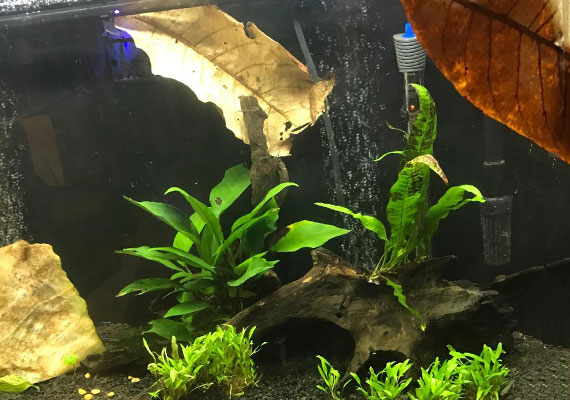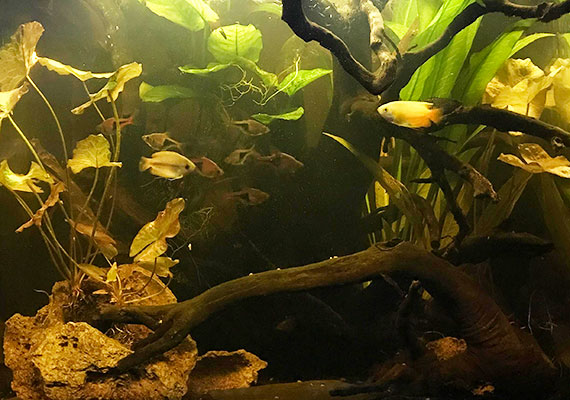
Natural Terminalia catappa leaves for your pond water treatment, aquarium natural cleaning. It normalize pH of water, prevent diseases, and inhibit the growth of algae in aquarium, etc.
Price: Per Lot $10
CHAT US ON WHATSAPP: https://wa.me/2348138570184
LEARN MORE ABOUT CATAPPA LEAVES
 |
| Terminalia catappa leaves |
Although in chemistry, most of us knows that to neutralize a substance or water that is alkaline, you need an acid to do, but we all know that most acid are toxic eg Sulfuric acid, Hcl, hydrochloric acid. If you are reading this article congratulations.
We want to introduce you to a natural way reduce your water alkalinity to neutral (ph 7.0) or highest ( 7.5 ph). You can do this by using Dry catappa leaves, porpularly known as fruit tree leaves in Nigeria and Indian Almond tree leaves.
Here is a video below after major studies of the leave in balancing ph of several water sources:
Watch Video:
LEARN MORE ABOUT CATAPPA LEAVES BELOW
Terminalia catappa tree – a tree that is native to Southeast Asia and has been used in traditional medicine there for centuries.[1]
If you are wondering what a Terminalia catappa tree looks like, here it is…
 |
| Terminalia catappa tree |
Once dried, they are ready to be used in ponds.
Let’s take a look at the most common uses for Indian almond leaves.
1. Improve the quality of your aquarium water

When added to your aquarium, an Indian almond leaf will gradually break down. And as it does, it releases tannic acid, tannins and other substances into your aquarium.
As the tannic acid is released, it lowers the pH of your water. If you want a natural solution to reduce the pH levels in your aquarium, Indian almond leaf helps to achieve just that.
A study has also found that Indian almond leaves can significantly decrease water hardness (GH), which can benefit those who use hard water in their aquariums.
Okay, but what good is that for your aquarium?
Well, the water out of your tap probably doesn’t match the ideal conditions of the fish you keep.
Indian almond leaves change the water so that it more closely resembles the habitat of your fish
2. Natural medication for skin problems
Many fish farmers swear by Indian almond leaf as a natural remedy for diseases or injury involving their fish’s skin or rather their scales.
It is believed the tannins released by Indian almond leaves kill bacteria, fungus and viruses, allowing an injured fish to heal much quicker.
It is even suggested that Indian almond leaf might be a better solution than antibiotics and other medications when fighting bacteria and fungus in commercial fish farms.
3. Food and protection for fry (baby fish)
Indian almond leaves are the gift that keeps giving, even once your fish have hatched.
Many fish keepers add Indian almond leaves to fry tanks – an aquarium that is set aside just for baby fish.
First, the leaves give fry a place to hide, allowing them to feel safe. Sure, there are no predators in your fry tank, but your tiny fish don’t know that.
As the Indian almond leaves begin to break down, microorganisms called infusoria appear and feed on the leaf.
Infusoria are so small that humans can barely see them with our naked eye. However, to your fry that are barely bigger than an eyelash, infusoria might as well be a steak dinner.
Newly hatched fry happily chow down on infusoria until they grow large enough that they need to switch to an alternate food source.
As Indian almond or catappa leaves break down, they release tannins. These tannins can stain your water, turning it a yellow or brown tinge.
It’s similar to dipping a tea bag into a hot cup of water. The tannins are released into the water, giving the tea its color.
To a beginner, this yellow water can be quite a surprise.
I mean, whenever you go to a fish store or aquarium, the water is crystal clear, right?
Well, it might surprise you to learn that this yellow water is actually a good thing for many types of fish.
You see, lots of fish come from waters that are a murky brown color.
Most rivers and streams are a dark color because thousands or even millions of leaves have washed into the water and broken down.
While you might not be crazy about the color, this darker water may reduce stress in shy fish like discus.
And since stress is the number one cause of death in fish, a little bit of yellow water is a small price to pay for the happiness of your fish.
In fact, many fish owners prefer darker water – it allows them to create unusual and stunning aquariums like this one…

Well, Indian almond leaves are unique in that they break down slower than other leaves. The leaves have big, tough veins that take a long time to deteriorate, long after the rest of the leaf has broken down.
The advantage to this is that you can pull the leaf out of your aquarium without it disintegrating into small pieces.
Also, while other leaves might give off tannins, Indian almond leaves also have medicinal properties – something that other leaves don’t offer.
How do you use Indian almond/ Catappa leaves?
So, you want to add Indian almond leaves to your pond?
Now that you have your Indian almond leaves on hand, it’s time to add them to your pond.
Dunking an Indian almond leaf in your tank
The most common way of using Indian almond leaves is to drop them directly into your tank. It’s generally recommended that you start with one medium-sized leaf for every 10 gallons of water inside your aquarium.
Please share, subscribe to our news letter and come back for more tips. Cheers!
...








